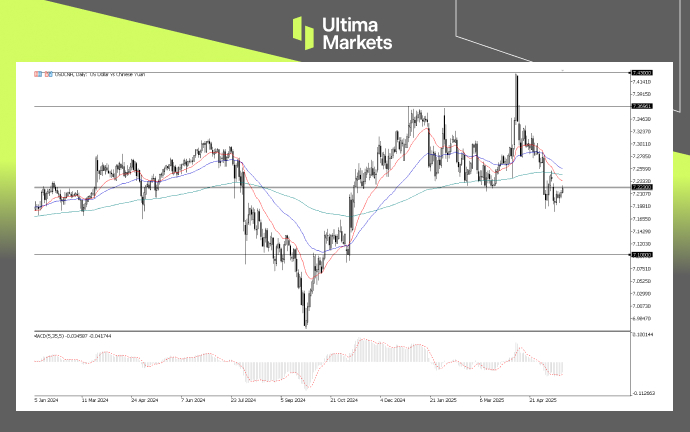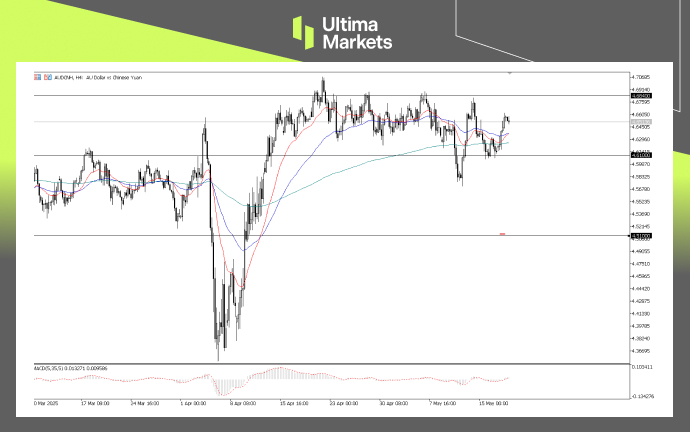PBoC Rate Cuts Spark Market Rally, Yuan Weakens
TOPICSTags: AUDCNH, Central Bank, Chinese Yuan, Economic Stimulus, Interest Rate, LPR, PBOC, USDCNH
On May 20, 2025, the People’s Bank of China (PBoC) announced a significant monetary policy easing by reducing its benchmark lending rates for the first time since 2024. The one-year Loan Prime Rate (LPR) was lowered by 10 basis point to 3.0%, and the five-year LPR, which influences the mortgage rates, was cut to 3.5%.
Economic Stimulation Amid Trade Tensions
The PBoC’s move is part of a broader strategy to stimulate the economy amid ongoing trade tensions with the United States and the domestic challenges such as the sluggish property market and declining consumer demand.
Besides the recent loan prime rate cuts, the PBoC has taken several other measures to support the economy, including:
- Reserve Requirement Ratio (RRR) Cuts: The PBoC has reduced the reserve requirement ratio for banks multiple times in recent months, freeing up liquidity to encourage more lending to businesses and consumers.
- Targeted Lending Programs: The central bank has introduced targeted lending facilities aimed at supporting small and medium-sized enterprises (SMEs) and key sectors like manufacturing and technology.
- Medium-term Lending Facility (MLF) Adjustments: The PBoC has adjusted interest rates and increased the availability of medium-term funds to banks to ensure sufficient credit flow to the economy.
The PBoC’s recent actions reflect a shift towards a more proactive monetary policy stance, signaling a commitment to supporting the economy through targeted easing measures.
What’s Next?
Looking ahead, market participants will closely monitor the potential for further fiscal stimulus and monetary easing in the near future.
Although China’s economy expanded modestly in Q1, recent data — including weak retail spending and renewed trade tensions in April — have raised concerns about a slowdown. The recent rate cuts aim to reduce borrowing costs, support mortgage lending, encourage business investment, and boost consumer credit.
“The PBoC’s willingness to cut rates signals its commitment to support the economy,” said Ultima Markets Senior Analyst Shawn. However, the effectiveness of these measures will depend heavily on investor and consumer confidence.
As such, “the PBoC is expected to maintain a more accommodative policy stance going forward.”, he added.
Market Reaction and Yuan Outlook
The recent wave of easing policies has boosted investor sentiment, with Asian stock markets reacting positively. At the time of writing, the China A50 rose by 0.6%, while Hong Kong’s Hang Seng Index gained 1%.
However, the Chinese Yuan edged lower against the U.S. Dollar despite dollar weakness, as markets expect a wider interest rate gap between the Fed and the PBoC.
The USDCNH had slipped sharply from its near two-decade high of 7.4300 over the past month, largely due to declining dollar appeal following April’s trade war developments.

USDCNH, Day Chart Analysis | Source: Ultima Market MT5
From a technical perspective, USDCNH briefly broke below the recent low of 7.2230 but rebounded following the PBoC’s rate cut.
With more easing measures likely ahead, further depreciation in the Yuan is possible. Unless the U.S. Dollar comes under renewed pressure, USDCNH may stay above this support in the near term.
Meanwhile, AUDCNH could gain bullish momentum if the Chinese Yuan continues to weaken on further easing measures. As a major exporter to China, Australia may benefit from increased Chinese stimulus spending, which could in turn support the Australian Dollar against the Yuan.

AUDCNH, Day-Chart Analysis | Source: Ultima Market MT5
Technically, the AUD shows a strong recovery against the CNH in April, potentially lead into a strong reversal. However recently consolidate within 4.684 to 4.610. The support 4.6100 could potentially kept the AUDCNH favorable to the upside in near-term.
Disclaimer
Comments, news, research, analysis, price, and all information contained in the article only serve as general information for readers and do not suggest any advice. Ultima Markets has taken reasonable measures to provide up-to-date information, but cannot guarantee accuracy, and may modify without notice. Ultima Markets will not be responsible for any loss incurred due to the application of the information provided.
Why Trade Metals & Commodities with Ultima Markets?
Ultima Markets provides the foremost competitive cost and exchange environment for prevalent commodities worldwide.
Start TradingMonitoring the market on the go
Markets are susceptible to changes in supply and demand
Attractive to investors only interested in price speculation
Deep and diverse liquidity with no hidden fees
No dealing desk and no requotes
Fast execution via Equinix NY4 server









